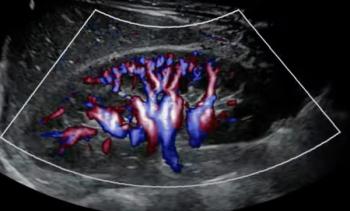
Former PACS company president turns attention to telemedicine
Former PACS company president turns attention to telemedicineCombining teleradiology and videoconferencing applications onone hardware system has long been a dream of telemedicine advocates.That dream is a bit closer to reality since a Florida
Former PACS company president turns attention to telemedicine
Combining teleradiology and videoconferencing applications onone hardware system has long been a dream of telemedicine advocates.That dream is a bit closer to reality since a Florida start-upcompany released software that allows low-resolution teleradiologyand videoconferencing consultations to be done on the same equipment.
Most of the people doing telemedicine have separate equipmentfor teleradiology and teleconferencing, even though those systemsmay share the same communications network, said Michael R. Kerouac,president of md/tv, a software developer based in Maitland, FL.
"Usually they're not using the same system (to do bothvideoconferencing and teleradiology), and they're not controllingboth applications from a single device, which is what we're doingright now," he said.
Kerouac was president of Genesys, a teleradiology and picturearchiving and communications systems integrator, for six yearsbefore starting md/tv (SCAN 4/7/93). Genesys developed PACS softwarefor IBM's RS/6000 workstation.
Md/tv has partnered with IBM to develop a telemedicine systemfor Emory University in Atlanta. Emory is helping md/tv designand evaluate its software by rotating the system through differentdepartments, Kerouac said. Such research will allow md/tv to tweakits software so it can be specially tailored for different telemedicalapplications, such as radiology, cardiology and dermatology.
Even though md/tv's telemedicine system incorporates teleradiology,Kerouac emphasized that the company's focus is not high-resolutionteleradiology. Most people interested in videoconferencing needcolor images, which are displayed on 8-bit gray-scale monitors.High-level diagnostic teleradiology, on the other hand, may requirea 12-bit gray-scale monitor, he said.
Md/tv's system can display radiology images at 1000 x 1000-pixels,8 bits deep, making it adequate for consultative interpretationsof ultrasound and CT images and for reviewing radiographs, hesaid.
While combining teleradiology and videoconferencing into onesystem seems to make sense, companies manufacturing those systemshave tended to focus exclusively on only one of the technologies.Part of the reason teleradiology and PACS companies haven't delvedinto videoconferencing is because radiologists tend to have limitedpatient contact and, thus, little need for interactive consultationcapabilities, Kerouac said.
"People who originally got into telemedicine were organizedaround videoconferencing and there didn't seem to be a lot ofcross experience and expertise," he said. "And to thisday, when I talk to GE and Picker, they have difficulty separatingcine of slices from motion video. There isn't a good understandingof what a multispecialty teleconferencing system and databasewould be about."
Some companies, such as Raytheon, CAE-Link and Martin Marietta,have that vision but are still trying to integrate the pieces,Kerouac said. He hopes to provide his software to hardware integratorswho are interested in creating multispecialty systems.
Kerouac said he got into telemedicine because he thinks ithas more potential for growth than either teleradiology or PACS.Telemedicine will only hit its true cost-saving potential, however,in a managed-care environment, where the technology can help dispersespecialist services throughout multiple hospitals and clinics,Kerouac said. He believes garnering reimbursement for telemedicalservices isn't the best way to further the technology's growth,considering the rapid growth of managed care.
"The real marketplace (for telemedicine) is in the managed-careenvironment and not multiple government reimbursements,"he said. "I've never thought that getting the governmentinvolved is the best way to develop new technology."
While md/tv won't directly market its product to customers,the company does plan to help hardware integrators market theconcept of telemedicine. To that end, md/tv has entered into ajoint venture with Emblematics, a Pittsburgh-based company, todevelop an artificial intelligence system for doing return-on-investmentanalyses for telemedicine.
That software will be able to extract information from thehospital's computers and then evaluate costs and revenues by diagnosis-relatedgroups associated with telemedicine. The result could be updatedregularly to chart the effectiveness of a telemedicine implementation,Kerouac said. The software could also be used to quantify theimpact of reimbursement changes as hospitals migrate toward capitationor a national health plan.
"It's important for us to give the care providers andhardware integrators a tool that would justify an investment intelemedicine," Kerouac said. "We want to help them createthe market as well as support it with our software."
Newsletter
Stay at the forefront of radiology with the Diagnostic Imaging newsletter, delivering the latest news, clinical insights, and imaging advancements for today’s radiologists.




























